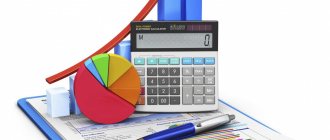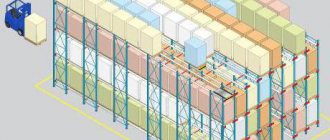The production reserves of any company form the main material base, that is, a complex of property assets from which and with the help of which finished products are produced and then sold. This process is the basis for the financial stability of an enterprise, so it is important to see the balance of inventory at the beginning and end of the reporting period in the balance sheet.
Inventories on the balance sheet are the cost of available working capital, indicating the extent to which the company is provided with material assets. By recording their value in the balance sheet, the enterprise indicates how much resources it has at the end of the reporting year. Let us recall what place these assets occupy in the balance sheet, what line is allocated to them and how the value reflected in it is formed.
The concept of an organization's reserves. Types of stocks
Every company that operates needs a variety of resources . If we talk about production organizations, then inventories play one of the leading roles in it. Resources in this case are consumed to manufacture products and satisfy their current needs .
Take our proprietary course on choosing stocks on the stock market → training course
For example, an enterprise that produces paving slabs at least has at its disposal special forms and mixtures for its production. The manufactured product is already stored as a commodity in a warehouse. Another example is a small accounting firm that provides outsourcing services. Even such an organization has paper, computer equipment, and stationery.
It turns out that all organizations, without exception, have at their disposal certain reserves.
Due to the fact that there are a great many reserves, they were combined into several groups. There are several classifications of reserves. Let's take a closer look at what stocks there are depending on their form. The following types are distinguished by type:
| Stock name | Account | Explanation |
| Stocks of raw materials and material resources | 10 | These are all those material assets that are used in the future in production, provision of services or carrying out current activities |
| Unfinished production | 20 | If a company produces products, then it probably has work in progress, that is, products that have not yet gone through the full production cycle. Different types of products may be at different stages of production |
| Finished products | 43 | After the production process is completed, the output is a full-fledged product, which is intended for further sale to customers. While the product is in the warehouse, it is also included in the organization’s inventory. |
| Waste | 10 | This is all that is no longer needed in the production cycle and will not be used in the company |
| Accessories | 10 | Supplies used for equipment maintenance, repair and maintenance |
It must be remembered that raw materials are a broad concept that includes various types of supplies.
Wiring example
Talisman LLC is engaged in retail trade and for office needs purchased 5 waste baskets for 16,000 rubles with VAT 2000.
The purchase was paid for in the current month, so the transaction was displayed in the accounting documentation as follows:
- Dt10 Kt60: 14,000 rub. excluding VAT, goods received from the seller;
- Dt19 Kt60: 2,000 rub. VAT
- Dt68 subaccount “VAT calculations” Kt19 - 2,000 rubles. as a claimed VAT deduction from the cost;
- Dt60 Kt51: 16,000 rub. paid as payment for waste baskets.
Organizational inventory accounts. Formula for calculating the amount of reserves
Since an organization’s reserves include many different types, there are quite a lot of accounts for their accounting. To calculate the amount of inventory for reporting, it is necessary to collect information on the following accounts:
- Account 10. It collects information about the cost of those material resources that are involved in the production of products. This includes the raw materials from which products are made, fuel, spare parts, containers, equipment and other similar property. Special clothing is also taken into account here.
- For livestock organizations, account 11 is relevant, which takes into account animals on the balance sheet
- When purchasing inventories, depending on the provisions of the accounting policy, accounts 15 or 16 can be used. When inventories are received from suppliers, in this case posting D15 (16) K60 is made. After registering, for example, fuel, a D10 K15(16) entry is made. But since this method of accounting is quite cumbersome and intermediate posting appears, these accounts are often not used
- The calculation involves accounts reflecting the presence of semi-finished products or defects - accounts 21 and 28, respectively. The amounts for them must be taken into account when calculating
- Information on different types of production is collected on accounts 20, 23 and 29
- The next large group for which information is collected when calculating data for line 1210 of the balance sheet concerns goods and products already produced. This includes accounts 41, 42, 43, 44, 45
- In addition, when calculating, the amount in account 97 is taken into account, but not all, but only that which relates to expenses written off during the year
Account 14 deserves special attention. The organization’s accounting policy may include a condition for creating a special reserve to reduce the cost of inventories. This reserve is created at the end of the year, before the balance sheet is formed. This occurs if the value of inventory at accounting prices is higher than at market prices. That is, the amount of the reserve is the difference between the book value and market value, multiplied by the amount of inventory .
The creation of such a reserve is reflected in D91 K14, and its write-off in D14 K91.
Accounting entries
The large number of accounting accounts, especially if we also take into account their subaccounts, leads to some confusion and hundreds of possible combinations. It is difficult to describe all the posting options, but we can highlight those that are most often used in accounting.
Fixed Asset Accounting
This includes all assets involved in production. Depending on the type of activity, these can be structures, tools, transport, perennial plants, animals. A special feature of this material base is their use time, which exceeds 12 months. If we talk about equipment that operates for a long period of time, its cost gradually decreases, approaching the cost of the product.
Postings of intangible assets
Intangible assets can be financially profitable without having a physical form, but with the ability to be identified. This may include the reputation of a unit or intellectual objects with a program, trademark or selection achievement.
Accounting for inventories
MTZ wiring is considered necessary due to the periodic purchase of component materials. This point is one of the simplest, so even for a novice accountant it is absolutely clear.
Important! Nowadays, fuel cards are very common and are used by many organizations related to transport movement. For inexperienced accountants, their accounting may be associated with some difficulties, because there is no precise legislative basis for this procedure.
Postings for production cost accounting
There are several required accounts for this action that can be confusing. In this case, it is necessary to specify the type of valuation taking place if it is planned to write off inventories from the balance sheet.
Accounting for goods and finished products
People who do accounting in trade organizations need to know the procedure for posting finished products. When purchasing goods from wholesale suppliers, you must carefully check the documents provided by the intermediary. Here you need to study all the conditions and not agree to an unfavorable offer.
Cash accounting
Almost all organizations and manufacturing enterprises work with financial turnover. For financial accounting, you need to work on accounts 50 and 51. Money is stored in a bank account or in a cash register; accordingly, there are several types of such transactions. It is important to remember the need to prepare all relevant documents for cash transactions, these could be advance reports, inventory reports, payment orders and cash orders.
Postings of loans and credits
Often in business activities financing or borrowed funds are used. To obtain a loan, a businessman needs to visit a bank. The accountant’s responsibilities include the formation of a credit transaction, which reflects the funds received and calculates the monthly payment schedule.
Accounting for final profit
Any entrepreneurial activity involves obtaining a final income. The result can be either unprofitable or profitable and is formed at the end of each reporting period. If the amount of income exceeds expenses, the company's profit increases. Revenue is recorded as a debit, and expenses as a credit. If at the end of the reporting period there is a credit balance, the organization makes a profit.
Important! Nowadays, there are many Internet services that lure inexperienced accountants by offering to prepare online entries absolutely free of charge. Of course, their use is not prohibited, but it should be understood that any financial transaction has its own nuances, so the result may not be entirely correct. Therefore, every accountant should thoroughly know all the accounts so that there is no need to use such programs.
Reflection of inventories in the organization's balance sheet
As can be seen from the above formula, account balances are involved in calculating the amount of inventory. In terms of materials, this means that all raw materials that are currently not used remain on the company’s balance sheet.
It must be remembered that materials are subject to accounting at actual cost, and VAT must be excluded from the cost.
An organization can account for inventories in account 10 at planned prices, using accounts 15 and 16.
| IMPORTANT! Information on line 1210 gives an idea of the financial stability of the company and the ability to perform this or that work. A missing inventory amount or a small line value is not a very good sign. If this is not related to serious problems in the company, then it is necessary to competently build a marketing line |
What does line 1210 of the balance sheet consist of?
Line 1210 of the balance sheet is called “Inventories”. As the name suggests, this line needs to be shown (clause 20 PBU 4/99):
- raw materials, materials and other similar values;
- costs in work in progress (distribution costs);
- finished goods, goods for resale and goods shipped;
- Future expenses.
This means that to fill out line 1210 of the balance sheet as of the reporting date, you need to add up the debit balance of the following accounts (Order of the Ministry of Finance dated October 31, 2000 No. 94n):
- 10 “Materials;
- 11 “Animals in cultivation and fattening”;
- 15 “Procurement and acquisition of material assets”;
- 16 “Deviation in the cost of material assets”;
- 20 “Main production”;
- 21 “Semi-finished products of own production”;
- 23 “Auxiliary production”;
- 28 “Defects in production”;
- 29 “Service industries and farms”;
- 41 "Products";
- 43 “Finished products”;
- 44 “Sales expenses”;
- 45 “Goods shipped”;
- 97 “Deferred expenses”.
We remind you that in the financial statements, indicators must be presented in a net assessment, i.e., minus regulatory values (clause 35 of PBU 4/99). This means that if an organization has an amount of reserve for depreciation related to inventories (credit balance of account 14 “Reserves for depreciation of material assets”) or a trade margin (credit balance of the same name account 42), the debit balance of the above accounts should be equal to their amount decrease. And the already “cleared” balance of inventories should be reflected on line 1210. And information about regulatory values that are not given separately in the balance sheet must be disclosed in the explanations to it.
Reflection of the cost of finished products in the balance sheet
Finished products produced by the company are accounted for on account 43. They are one of the components of the organization's reserves and, in accordance with this, are shown in the balance sheet at actual cost.
However, there is a nuance here. Until the product has gone through all stages of production, it is impossible to calculate the actual costs of its creation. In this regard, it is customary for organizations to keep records of such products within a month at discount prices that are chosen by the company . At the end of the month, after all operations have been completed, actual production costs are collected and the cost of production is adjusted.
The following entries are made:
- The accounting value of products can be reflected as D43 K40 or D43 K20 (20, 29). The organization itself decides which method to choose.
- The difference between the accounting value and the actual value is reflected in D40 K20 (23, 29) or D43 K20 (23, 29). The posting is selected depending on which accounting method was selected
After the products are sold and written off, a balance appears, the amount of which should be reflected in line 1210.
Cancellation of a separate procedure for accounting for special items
FSBU 5/2019 does not identify special items as a separate type of inventory - special tools, fixtures, equipment and clothing. The guidelines for their accounting are also cancelled, so “non-standard” accounting rules can no longer be applied.
The costs of purchasing special items must be taken into account in a general manner.
- If special items are used for more than 12 months (or more than one operating cycle lasting more than 12 months), they are recorded as part of property, plant and equipment.
- If less - as reserves according to FAS 5/2019, that is, with the cost attributed to expenses or to the cost of finished products (works, services) at the time of transfer to operation.
Work in progress in the company's annual reporting
Everything that was unfinished in the reporting period is work in progress. These are products that have not passed all stages of the production process or quality control, or unprovided services.
Unfinished processes are reflected in accounts 20, 23, 29, 44, 46. Accordingly, the balances on these accounts will be the value of work in progress.
As a general rule, the volume of work in progress should be reflected in line 1210.
In addition, it is possible to select a separate substring if the amount is really large.
If production is very long, then information about work in progress can be reflected in the first section of the balance sheet.
Line 1210 “Inventories”: how to fill out correctly
Line 1210 “Inventories”
On line 1210
information about the organization's reserves is reflected:
(in terms of raw materials, materials and other inventories)
(in terms of raw materials, materials and other inventories)
(for expenses with a write-off period not exceeding 12 months)
The following assets are accepted as inventories:
- used as raw materials, materials, etc. in the production of products intended for sale (performance of work, provision of services);
- intended for sale;
- used for the management needs of the organization.
Finished products are part of inventories intended for sale (the final result of the production cycle, assets completed by processing (assembly), the technical and quality characteristics of which comply with the terms of the contract or the requirements of other documents, in cases established by law).
Goods are part of inventories purchased or received from other legal entities or individuals and intended for sale.
The actual costs of purchasing inventories include:
- amounts paid in accordance with the agreement to the supplier (seller);
- amounts paid to organizations for information and consulting services related to the acquisition of inventories;
- customs duties;
- non-refundable taxes paid in connection with the acquisition of a unit of inventory;
- remunerations paid to the intermediary organization through which inventories were acquired;
- costs for the procurement and delivery of inventories to the place of their use, including insurance costs. These costs include, in particular, costs for the procurement and delivery of inventories; costs of maintaining the procurement and warehouse division of the organization, costs of transport services for the delivery of inventories to the place of their use, if they are not included in the price of inventories established by the contract; accrued interest on loans provided by suppliers (commercial loan); interest on borrowed funds accrued before the inventory was accepted for accounting, if it was raised for the acquisition of these inventories;
- costs of bringing inventories to a state in which they are suitable for use for the intended purposes. These costs include the organization’s costs of processing, sorting, packaging and improving the technical characteristics of received stocks, not related to the production of products, performance of work and provision of services;
- other costs directly related to the acquisition of inventories.
This is interesting: Contacting a bank about the impossibility of repaying a loan
When releasing inventories (except for goods accounted for at sales value) into production and otherwise disposing of them, they are assessed in one of the following ways:
- at the cost of each unit;
- at average cost;
- at the cost of the first acquisition of inventories (FIFO method).
In the financial statements, at least the following information is subject to disclosure, taking into account materiality:
- on methods for assessing inventories by their groups (types);
- about the consequences of changes in methods of valuing inventories;
- on the cost of inventories pledged;
- on the amount and movement of reserves for reducing the value of material assets.
Animals for growing and fattening include:
- young animals;
- adult animals in fattening and feeding;
- birds;
- animals;
- rabbits;
- bee families;
- adult cattle culled from the main herd for sale (without fattening);
- livestock accepted from the population for sale.
When forming expenses for ordinary activities, their grouping should be ensured by the following elements:
- material costs;
- labor costs;
- contributions for social needs;
- depreciation;
- other costs.
Products (works) that have not passed all stages (phases, redistributions) provided for by the technological process, as well as incomplete products that have not passed testing and technical acceptance, are classified as work in progress.
Work in progress in mass and serial production can be reflected in the balance sheet:
- according to actual or standard (planned) production cost;
- by direct cost items;
- at the cost of raw materials, materials and semi-finished products.
The goods shipped may include:
- finished products (finished products);
- goods;
- work;
- services;
- animals for growing and fattening;
- semi-finished products of own production;
- materials and other similar valuables.
Selling expenses
If the amount of transportation and procurement costs associated with the acquisition (procurement) of goods and their delivery to the organization constitutes a significant share in the total revenue from sales of goods (more than ten percent), as well as if their level is uneven throughout the year (products crop production, fishing, etc.), then a proportional distribution of these expenses is allowed between the actual cost of goods sold in a given month and their balance at the end of the month. In this case, the share attributable to the balance of goods not sold by the end of the month remains in account 44 “Sales expenses” and is transferred to the next month.
In organizations engaged in industrial and other production activities, account 44 “Sales expenses” may reflect, in particular, the following expenses: for packaging and packaging of products in finished product warehouses; for delivery of products to the departure station (pier), loading into wagons, ships, cars and other vehicles; commission fees (deductions) paid to sales and other intermediary organizations; on the maintenance of premises for storing products at places of sale and remuneration of sellers in organizations engaged in agricultural production; for advertising; for entertainment expenses; other expenses similar in purpose.
In organizations engaged in trading activities, account 44 “Sales expenses” may reflect, in particular, the following expenses (distribution costs): for the transportation of goods; for wages; for rent; for the maintenance of buildings, structures, premises and equipment; for storage and processing of goods; for advertising; for entertainment expenses; other expenses similar in purpose.
In organizations that procure and process agricultural products (beets, milk, wool, cotton, leather raw materials, flax, livestock, poultry, etc.), account 44 “Sales expenses” can reflect, in particular, the following expenses: other expenses ; general procurement expenses; for the maintenance of procurement and receiving points; for the maintenance of livestock and poultry at bases and reception points.
This is interesting: Final act based on the results of a periodic medical examination
PBU 5/01 “Accounting for inventories”
Buyers are organizations, enterprises and individuals who purchase a product from an enterprise. Along with buyers, customers are also taken into account; these are enterprises and organizations to which this enterprise provides services or performs any work.
Settlements with them are formalized by settlement documents - these are invoices and invoices. Based on these documents, settlements with buyers and customers are reflected in accounting. These documents reflect all the details of the supplier and buyer:
— name of goods, works, services; - unit of measurement; - quantity; — price; - price; — VAT; - all to the calculation.
Documents are signed by the manager, chief accountant, and stamped. They are registered and sent to buyers for settlements.
An example of calculating the amount of reserves to be reflected in the balance sheet
Let's give a simple practical example of calculating the value of line 1210 of the balance sheet. We present the company's initial data in the table. It is assumed that there are no initial balances.
| Account | Turnover | balance | ||
| Debit | Credit | Debit | Credit | |
| 10 | 29000 | 17000 | 12000 | |
| 20 | 305000 | 300000 | 5000 | |
| 41 | 200000 | 150000 | 50000 | |
| 42 | 150000 | 200000 | 50000 | |
| 44 | 250000 | 200000 | 50000 | |
| 45 | 20000 | 15000 | 5000 | |
Based on the given data and guided by the calculation formula, in line 1210 you need to write down the final value - 72,000 rubles:
12000 + 5000 + 50000 – 50000 + 50000 + 5000 = 72000 rubles
One more thing. Many companies have insurance that is accounted for as deferred expenses. For example, on October 1, a car was insured. The cost of insurance was 12,000 rubles. These expenses are included in expenses in equal monthly shares. Therefore, the monthly amount will be 1000 rubles (12000/12 months). By the end of the year, 3,000 rubles (1,000*3 months) will be written off. The balance in the amount of 9,000 rubles (12,000-3,000) is transferred to the next year. This amount must be recorded in line 1210.
Scope of application
The chart of accounts is a list systematized on the basis of the economic content of each position included in it. The current list is a mandatory basis for drawing up a working chart of accounts for all organizations operating on the territory of the Russian Federation and maintaining accounting using the double entry method. The exception is banks and government agencies.
The double entry method is a registration system that involves simultaneous reflection of a transaction on two accounts: withdrawal ( credit ) of a certain amount of money from one and receipt ( debit ) of the same amount to another account .
Chart of Accounts Structure
PAS for commercial organizations is a scheme that allows you to register and group facts of economic activity (assets, liabilities, financial and business transactions, etc.).
It contains accounts of the first order. They are called synthetic, and each has a name and number.
Three types of synthetic accounts:
- Active. Their balance can only be debit; an increase in funds is always reflected in a debit, a decrease in a credit.
- Passive. Their balance can only be credit; an increase in funds is always reflected as a credit, a decrease as a debit.
- Active-passive. Their balance can be either debit or credit; an increase (decrease) in funds is reflected either as a debit or as a credit.
Also, the PSBU contains second-order accounts. They are called subaccounts. Several subaccounts can be opened for one synthetic account.
Fill out and print your balance sheet using the current form for free
Notes on future expenses
In order for the documents to reflect costs in subsequent periods, they must be described according to all the rules. This can be done on the balance sheet line, but this accounting procedure must be noted in the company’s accounting policy. For example, account 97 will allow you to create additional subaccounts in line 1210, which will contain information about expenses in the following purchasing periods.
All resources used for production are accounted for in the debit balance of account 10. For this, the initial price of those goods that will be written off before the end of the next reporting period is used. To simplify this process, accounts 15 and 16 are usually taken. The first reflects information about acquired and procured assets, the cost of material assets, the second - about deviations in their cost. This allows you to describe materials and raw materials, as well as reflect their accounting price in as much detail as possible.
Information about manufactured products is included in line 1210.
Here it is important to mention account 14. It will come in handy if production decides to create a reserve fund, with the help of which it will be possible to depreciate the total amount of inventory. Depreciation here is a decrease in the value of inventories.
So, in account 14, raw materials and supplies are recorded, minus the reserve for their depreciation. Subsequently, their cost should be several times lower than the initial one by the date of the report. To determine whether these conditions are met, an impairment test is performed:
- It is determined which assets are involved in testing.
- The value of the asset to be recovered is calculated.
- Impairment losses are determined.
- The loss is recognized as a gain or loss from impairment over a specified period of time.
- An analysis of the resulting calculations is being prepared.
- All data is documented.
- Reporting is completed.
Thanks to this process, it is possible to reduce the price of consumed resources several times, thereby stopping overconsumption in further periods.
The company's reserves noted in the documentation allow us to assess its material security. The availability of resources must be maintained at a certain level so that there is no shortage or overexpenditure in the reserve. The balance sheet stability of an organization's inventory indicates its competent management policy and good marketing, since the income of the entire enterprise depends on the speed of inventory turnover.






